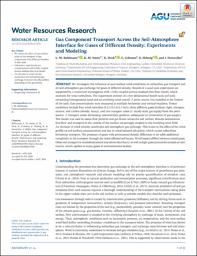
ATTENTION: The works hosted here are being migrated to a new repository that will consolidate resources, improve discoverability, and better show UTA's research impact on the global community. We will update authors as the migration progresses. Please see MavMatrix for more information.
Show simple item record
| dc.contributor.author | Bahlmann, L. M. | |
| dc.contributor.author | Smits, K. M. | |
| dc.contributor.author | Heck, K. | |
| dc.contributor.author | Coltman, E. | |
| dc.contributor.author | Helmig, R. | |
| dc.contributor.author | Neuweiler, I. | |
| dc.date.accessioned | 2021-05-28T16:43:39Z | |
| dc.date.available | 2021-05-28T16:43:39Z | |
| dc.date.issued | 2020-08-03 | |
| dc.identifier.issn | 1944-7973 | |
| dc.identifier.uri | http://hdl.handle.net/10106/29743 | |
| dc.description.abstract | **Please note that the full text is embargoed** ABSTRACT: We investigate the influence of near-surface wind conditions on subsurface gas transport and on soil-atmosphere gas exchange for gases of different density. Results of a sand tank experiment are supported by a numerical investigation with a fully coupled porous medium-free flow model, which accounts for wind turbulence. The experiment consists of a two-dimensional bench-scale soil tank containing homogeneous sand and an overlying wind tunnel. A point source was installed at the bottom of the tank. Gas concentrations were measured at multiple horizontal and vertical locations. Tested conditions include four wind velocities (0.2/1.0/2.0/2.7 m/s), three different gases (helium: light, nitrogen: neutral, and carbon dioxide: heavy), and two transport cases (1: steady-state gas supply from the point source; 2: transport under decreasing concentration gradient, subsequent to termination of gas supply). The model was used to assess flow patterns and gas fluxes across the soil surface. Results demonstrate that flow and transport in the vicinity of the surface are strongly coupled to the overlying wind field. An increase in wind velocity accelerates soil-atmosphere gas exchange. This is due to the effect of the wind profile on soil surface concentrations and due to wind-induced advection, which causes subsurface horizontal transport. The presence of gases with pronounced density difference to air adds additional complexity to the transport through the wind-affected soil layers. Wind impact differs between tested gases. Observed transport is multidimensional and shows that heavy as well as light gases cannot be treated as inert tracers, which applies to many gases in environmental studies. [©2020. The Authors. This is an open access article under the terms of the Creative Commons Attribution License, which permits use, distribution and reproduction in any medium, provided the original work is properly cited. This is a published version of an article published by Wiley, American Geophysical Union in Water Resources Research on September 2020, available online: https://doi.org/10.1029/2020WR027600] | en_US |
| dc.language.iso | en_US | en_US |
| dc.publisher | Wiley; American Geophysical Union | en_US |
| dc.relation.ispartofseries | Water Resources Research;Volume 56, Issue 9 | |
| dc.title | Gas Component Transport Across the Soil-Atmosphere Interface for Gases of Different Density: Experiments and Modeling | en_US |
| dc.type | Article | en_US |
| dc.identifier.doi | 10.1029/2020WR027600 | |
Files in this item
- Name:
- Gas-Component-Transport.pdf
- Size:
- 4.399Mb
- Format:
- PDF
- Description:
- PDF
This item appears in the following Collection(s)
Show simple item record


